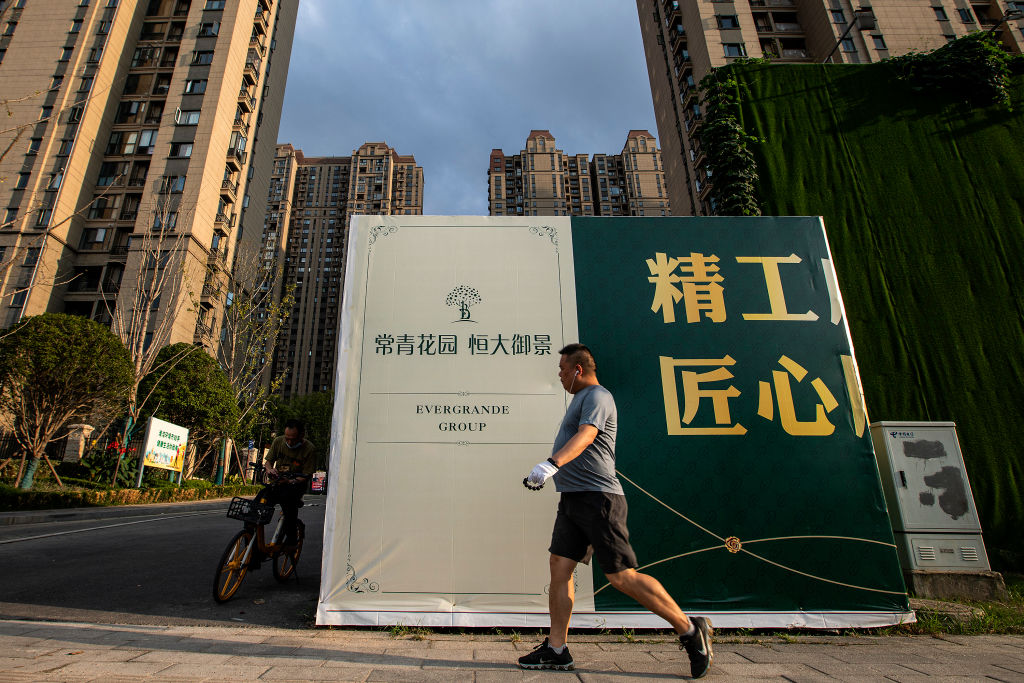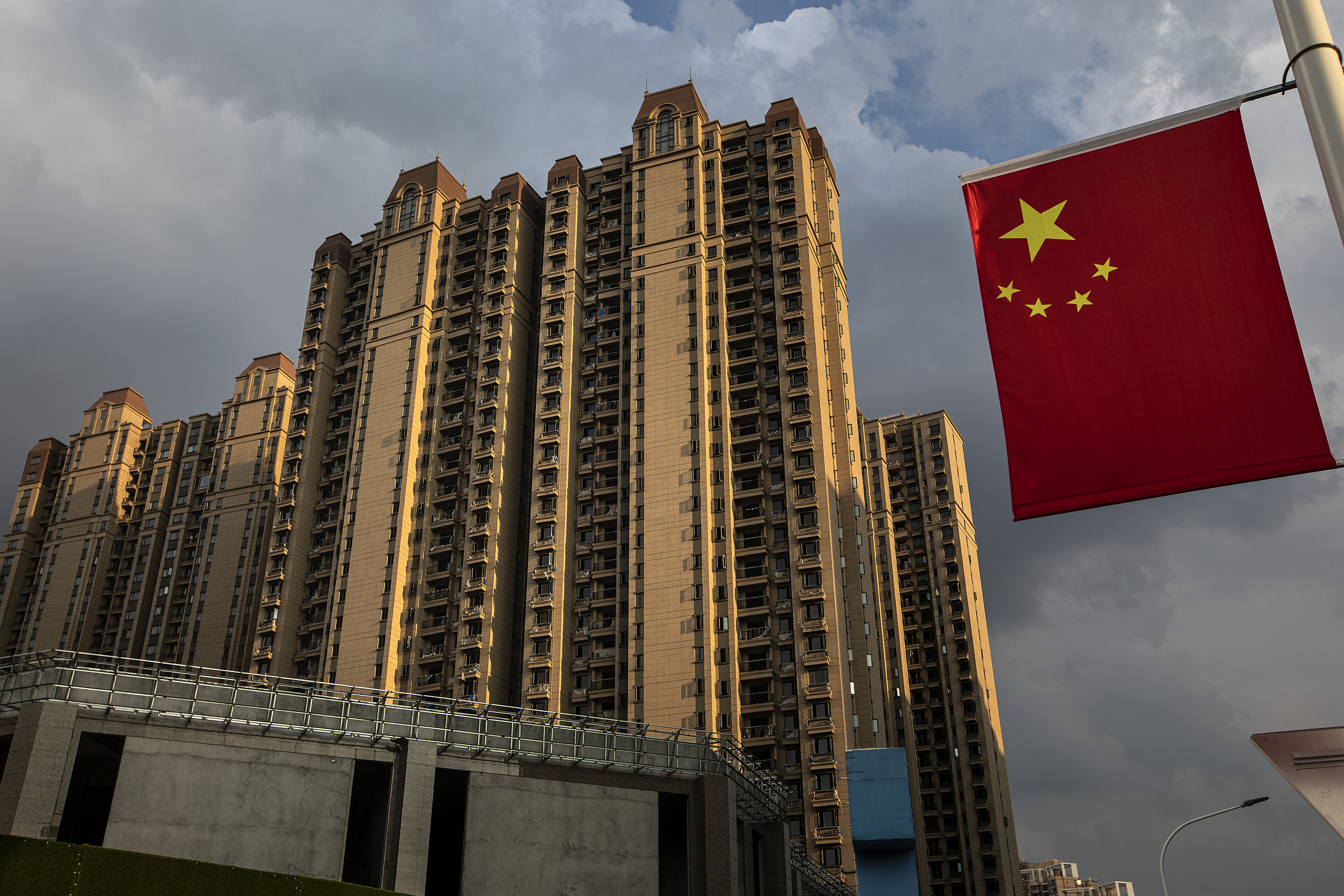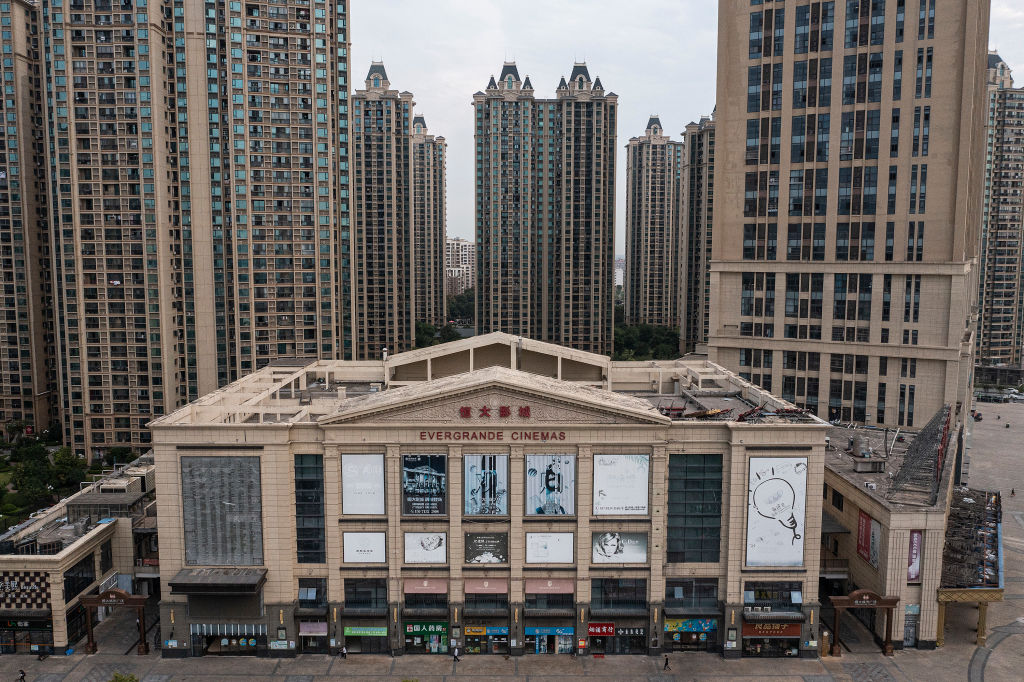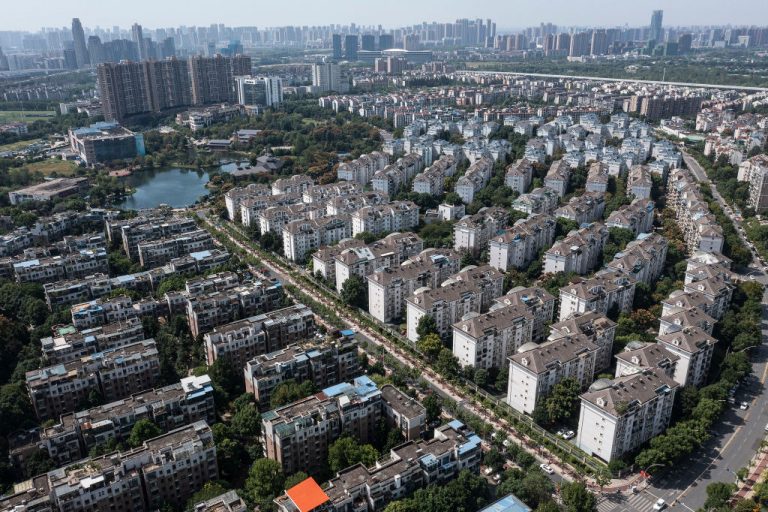Commentary by Cheng Xiaonong
An overarching illusion about China’s prosperity concerns the “construction boom” brought about by China’s real estate bubble. The bubble is expected to burst eventually, but no one would have expected the first “domino” to fall in China’s real estate industry to be Evergrande Group, China’s so-called No. 1 real estate company. Evergrande often boasts itself as being “too big to fail.” However, what’s happening now is “when the biggest one falls, the storm will be the biggest.” The Evergrande storm has already hit Wall Street and undermined China’s economic blueprint. The troubled times, or “an eventful fall” as the Chinese call it, has begun in China. It will probably not end this fall but will extend for quite a long time.
I. A big hole in China’s real estate bubble
For years, virtually the entire world seemed to believe that China’s economic boom is an inevitable trend that will keep going. I have argued that “China’s economic growth over the past 20 years or so has been built on one-time opportunities such as the ‘export boom’ and the ‘construction boom’ that are unlikely to replicate and therefore are not sustainable.
On the other hand, the Chinese economy has amassed a series of severe and almost unsolvable problems that makes it challenging for the CCP to seek further economic prosperity. One of the worst economic challenges that the CCP has created for itself, is the real estate bubble that it has to sustain.
Although many people in China know that the real estate bubble will burst sooner or later, few people want to believe that it will come so fast. The Chinese Communist Party (CCP) has been trying to regulate real estate activity by restraining it from its continuous expansion and sustaining it from suddenly bursting at the same time.
Success
You are now signed up for our newsletter
Success
Check your email to complete sign up
It’s like a “mission impossible.” The reality is that as long as the housing bubble “shines” under the sun, the Chinese people will hold on to the hope that the government will be able to sustain it. It is not until a hole emerges in the bubble do they realize that something has gone wrong, and the bubble is not sustainable after all.
Recently, China’s real estate giant, Evergrande Group, experienced a break in its capital chain and began defaulting on its maturing financial products. To deal with the crisis, it began to sell off its residential properties under construction and even used unfinished projects to pay off debts owed to other companies. Its impact can be felt on the Hong Kong stock market and Wall Street. It is becoming a storm that is under close watch by the international financial media. Still, some people think that Evergrande is only a drop in the ocean despite its size, and its collapse will not damage China’s massive economy. So, how did the Evergrande storm start, and what does it mean for China’s economy?

II. Evergrande is like having eight jars with only seven lids. It tried to cover all the jars but eventually failed
Evergrande has been using various financing tactics to raise money for the sake of expansion. It created an impression that everything was smooth. Yet, in reality, even the slightest storm would break its capital chain, leading one of the “jars” to be “flooded” and putting all of the “jars” in jeopardy.
Evergrande headquarters transferred the capital collected by Evergrande Wealth, through financial products, to fill the capital hole of its construction projects, failing to return the principal and interest to Evergrande Wealth. As a result, the financial products of Evergrande could not be redeemed at maturity, revealing to the public the actual status of Evergrande.
How many holes does Evergrande have, and when did it start to have problems? The Chinese media Caixin Weekly published two investigative reports on its Wechat page a few days ago, revealing much insider information. These two articles are titled “How Evergrande Got Here ( Part 1 ) – Crisis Hits” and “How Evergrande Got Here ( Part 2 ) – Tracing the Root of the Crisis“. However, under the pressure of authorities, Caixin had to delete the articles quickly. Here are the key points from these two articles.
First of all, even though Evergrande is known as the No. 1 real estate company in China, it was severely strapped for capital and had to raise a lot of money illegally through Evergrande Wealth to fund its residential projects.
A few years ago, Evergrande’s fund-raising branch “promoted its own financial products to all employees within the company, even allocated sales targets, and later conducted regular work performance reviews based on the sales,” forcing employees to invest and seek out external connections in order to meet the sales quotas.
When its subcontractors requested payments, Evergrande required them to purchase Evergrande’s financial products. “The amount is about 10% of the project payment. Although it is not mandatory, construction companies often purchase the products to maintain a good relationship with Evergrande.” Despite various means of raising funds to finance construction projects, Evergrande was still unable to maintain the normal operation of its construction sites. In August 2021, “more than 500 of Evergrande’s more than 800 projects nationwide were in a state of standstill.”
Secondly, Evergrande owed huge amounts of money to construction companies. By August 2020, Evergrande had 8,441 upstream and downstream partners, among which a majority of them had payments defaulted on by Evergrande. Evergrande used its own unsecured short-term bills — also known as commercial bills — to pay these debts. As found in Evergrande’s financial report, “trade payables and other payables amounted to 951.133 billion RMB or 147.21 billion USD” as of June 30, 2021.
Thirdly, while the debt is mounting, Evergrande’s assets are shrinking. “As of the end of June 2021, Evergrande has total assets of 2,377.5 billion RMB and total liabilities of 1,966.5 billion RMB. Among these nearly 2,000 billion RMB in liabilities, the interest-bearing liabilities are 571.7 billion RMB.”
The so-called interest-bearing liabilities are the sums borrowed by Evergrande. After deducting the interest-bearing liabilities, the main body of the total liabilities is the payables and pre-receipts, nearly 1.4 trillion RMB. The payables are the construction money owed by Evergrande, while the pre-receipts are the purchase money from the pre-sale of homes, which have not yet been constructed or completed. From the book, it seems that Evergrande has more than 400 billion RMB net assets after deducting total liabilities, the main part of which is purchased land and construction in progress. However, such a net asset figure is not reliable.
Why?
On the one hand, the acquisition price of the land is much lower than the market price, on which the real estate company can profit. However, if the land is not developed during the term, as per the land sale contract of the local government, — usually a few years — the local government may take back the land, resulting in Evergrande’s vacant land disappearing from the net assets. Furthermore, if there is no capital available for projects under construction, the value of uncompleted buildings is virtually zero. On the other hand, Evergrande also has a large amount of debt hidden outside its financial statements. “It is a well-known secret that real estate companies have a lot of off-balance sheet liabilities. It remains a mystery how much off-balance-sheet debt Evergrande has, and whether it exceeds the current net assets of Evergrande.”

III. The Evergrande storm has dispelled three myths concerning China’s real estate industry
The reason why China’s real estate bubble has grown over the years without bursting is that, in addition to the local government’s efforts to protect it by all means, three myths have been holding up the housing bubble psychologically.
The first myth is that “real estate companies won’t collapse if they are big.” Evergrande has been expanding because one of its tenets is “if it is big, it will not fail,” convinced that the government will not let it fall. Homebuyers in China also believe it.
On August 2, 2021, Fortune magazine announced the world’s 500 largest companies. Evergrande Group ranked 122nd in the world. Among the eight Chinese real estate companies on the list, Evergrande ranked first. However, the top real estate company in China is now in trouble. The reality that Evergrande might not survive has destroyed the myth of “too big to fail”, not to mention small and medium-sized companies.
The second myth is that “pre-sale homes are safe.” Many homebuyers in China are now buying homes and placing orders after seeing a model home or a blueprint. The real estate companies take advantage of home buyers’ eagerness to get a new home and use the prepayment as the capital for its construction. However, the lesson of Evergrande tells the Chinese people that if the turnover of a real estate company’s capital fails, the pre-sale homes may become undeliverable or a “tower in the air.” The buyers might end up with nothing despite having made the payment.
According to a report sent by Evergrande Group to the Guangdong Provincial Government in August 2021, in Guangdong Province alone, “the number of commercial properties sold by Evergrande Group without delivery as of June 30, 2020 is 617,000 sets. If Evergrande Group falls into crisis, 2.04 million owners will face the risk of uncompleted projects or failure to take possession of their properties.”
The third myth is that “China’s housing prices won’t drop.” In order to repay the debts, Evergrande started to discount the residential units under construction, which had an impact on the whole real estate market. For individual customers of financial products, Evergrande headquarters use physical assets to pay off cash debts. Du Liang, the person in charge of Evergrande Wealth, said, “When offsetting physical assets, residential homes and apartments are discounted by 7.2 % and 5.4 % respectively according to the current selling price, while retail shops and parking spaces are discounted by 4.8 % according to the current selling price.” At the same time, “for the overdue commercial bills, Evergrande offered a solution of ‘offsetting the debt with properties.’”
For example, in the past two months, Evergrande, due to the cash shortage, has paid off the debts of a painting company named “Three Trees” “by using the three properties located in the city of Wuhan, Ezhou and Shenzhen, with the expected completion and delivery dates of 2022, 2024 and 2023 respectively. It is possible that the properties used to offset the debts will flow to the market.” The creditors will sell the properties at low prices regardless of the current prices in the local real estate market in order to recover the cash as soon as possible. “The company Three Trees has already started to dispose of these properties.”
The debunking of these three myths will, on the one hand, have a massive impact on the nationwide home buyers’ psychology. Many people who originally intend to buy a home will have to consider it more carefully. On the other hand, Evergrande’s discounting action will cause a “ripple effect” of falling home prices, bringing down home prices faster in many cities.

IV. The new and more restrictive government policies for real estate financing will devastate real estate companies in China
For more than a decade, local governments in China have relied heavily on land sales for revenue. Many banks have invested in real estate projects or provided mortgages to home buyers. The central government is increasingly worried about the possibility of a bursting real estate bubble and its implications for local governments and banks. If the real estate bubble bursts, there will be a large number of bad debts, resulting in a crisis in the banking sector, and with the high dependence of local finances on the real estate, local finances could collapse along with it. Therefore, since 2017, Beijing has been trying to stop the feverish development of the real estate industry by gently squeezing the real estate bubble through multiple means such as restrictions on purchases, prices, and loans.
In the aftermath of the pandemic, the central government has become even more concerned that the real estate sector or “the flagship sector in China” is drawing too many financial resources from society and causing consumer spending to shrink and the economy to lose momentum. So, it started to further clamp down on the sector. In August 2020, the CCP drew “3 red lines” for real estate companies to limit their bank loans. The three lines are: the balance sheet ratio (i.e., liabilities divided by assets), excluding pre-receipts, must not be higher than 70%; the net debt ratio of real estate companies must not be greater than 100%; the cash short term debt (i.e., cash divided by short term debt) ratio must not be less than 1.
The new policy stipulates, if a real estate company steps on all three “red lines,” it can no longer borrow from banks; if it steps on two “red lines,” its annual growth rate of interest-bearing debt shall not exceed 5%; if it steps on only one “red line,” its annual growth rate of interest-bearing debt shall not exceed 10%; if none of the three “red lines” are crossed, its annual increase in an interest-bearing debt shall be 15% at most. In this way, the common practice of borrowing new debts to repay old ones can no longer work for real estate companies. When they can’t borrow enough loans and old debts must be repaid, these companies will fall into insolvency.
Evergrande is not the only unlucky one under the new policy of real estate financing. Since its implementation at the beginning of 2021, real estate companies have struggled in deep water for 8 months. By September 5th, 274 real estate companies nationwide had declared bankruptcy, an average of one a day. The first to go bankrupt was small real estate companies with weak capital strength, and then it was Evergrande. As long as the new policy is in place, the financial pressure on real estate companies will just become more immense.

V. The significance of the Evergrande storm for China’s economy
It can be said that the Evergrande storm has informed the CCP of the necessity of a new financing policy for real estate companies and the danger of the accelerated deflation of the real estate bubble. Although Evergrande alone is unlikely to drag the whole real estate industry into the abyss right away, the storm it started has proven that the real estate-based growth in China has come to an end. Furthermore, the real estate bubble has become a heavy burden to the whole economy. Praise for the “construction boom” is unlikely to be heard in China again.
The CCP’s new financing policy for real estate companies is focused on preserving banks at the expense of real estate companies, which is somewhat tantamount to “breaking the arm to survive.” As for Evergrande, the authorities would like to see it manage its complicated debts and rapidly shrinking assets on its own. By doing so, they also want to understand how bad the Evergrande storm could turn out to be.
The Evergrande storm represents the beginning of China’s real estate bubble bursting, probably the first “domino” to trigger the domino effect that will soon appear in the real estate industry. How other real estate companies will hold up does not depend entirely on their efforts alone, but to a greater extent on the general economic environment in China. If home prices continue to drop, the government is bound to sacrifice more real estate companies to save the banks. Such a situation would exacerbate China’s economy, which is already struggling with sluggish domestic spending and rising industrial prices. It would overshadow the Communist Party’s trumpeting of an economic recovery. The Wall Street Journal devoted several articles on September 22 to analyze the negative impact of the Evergrande storm on China’s economy, including one with the headline “Evergrande Is China’s Economy in a Nutshell .”
The international society already feels the Evergrande storm. Media from all over the world, including the financial media in the U.S., have continuously reported its impact. After Evergrande’s predicament became public, it hit the Hong Kong and New York stock markets.
In the New York exchange, not only were Chinese concept stocks and Chinese bond funds hit, but also US companies. For example, the two most notable downturns are Caterpillar Inc., which makes and sells construction machinery in China, and Goldman Sachs Group Inc., an avid dealer, and investor in bonds of Chinese companies involved in housing.
Although Evergrande is not so big as to change the direction of the global economy, it has exposed the economic risks of China, which is so big that the global investment community will re-evaluate it. They will become more cautious in their future investments in China and may even withdraw some. Such an international trend is bound to add pressure on China. Chinese companies, desperate to raise funds by selling bonds to Western countries, may lose their “charm” of attracting foreign capital. Moreover, the increasing caution of foreign investors will make the Chinese economy less able to count on foreign capital.
Regardless of Evergrande’s fate, it has already left its name in history. In the future, when experts in world economic history describe the decline of China’s economy, they will probably start their chapters with phrases like “Since the Evergrande incident…”, which is the significance of paying attention to the Evergrande storm today.
Dr. Cheng Xiaonong is a scholar of China’s politics and economy based in New Jersey. Cheng was a policy researcher and aide to late Chinese statesman Zhao Ziyang when the latter served as premier. Cheng has also been chief editor of the journal Modern China Studies.














